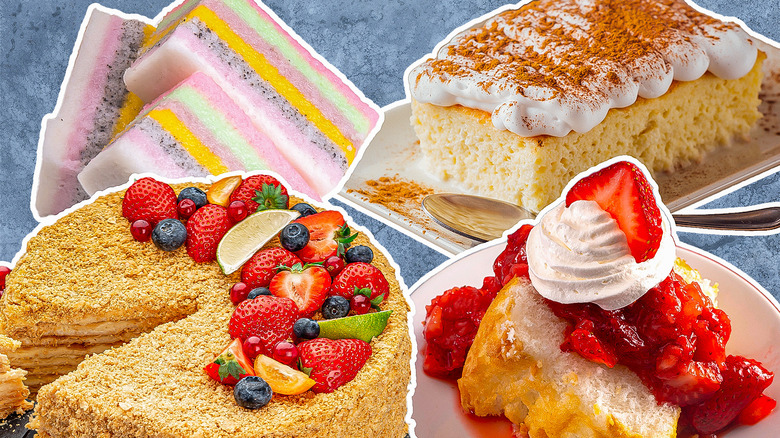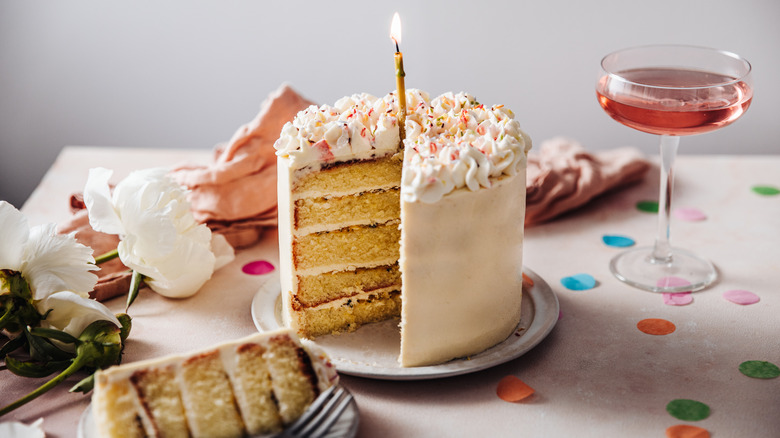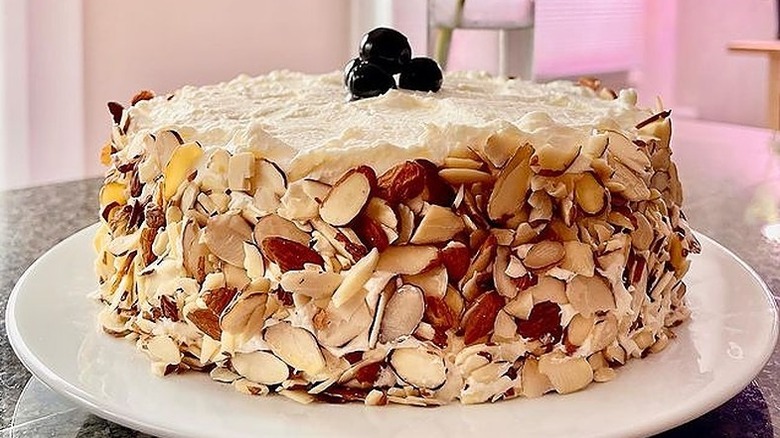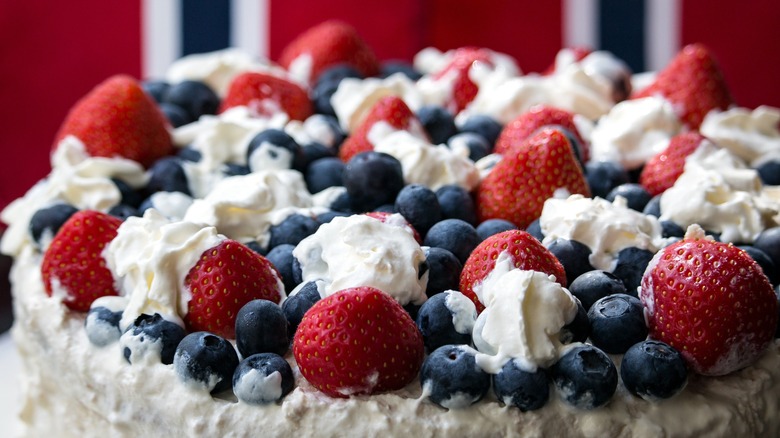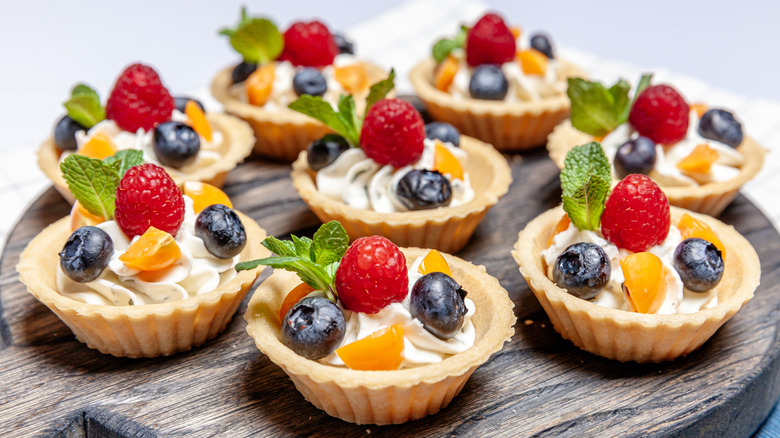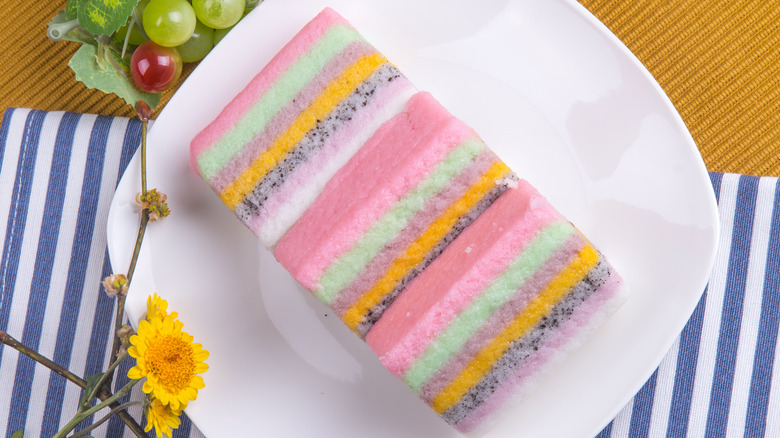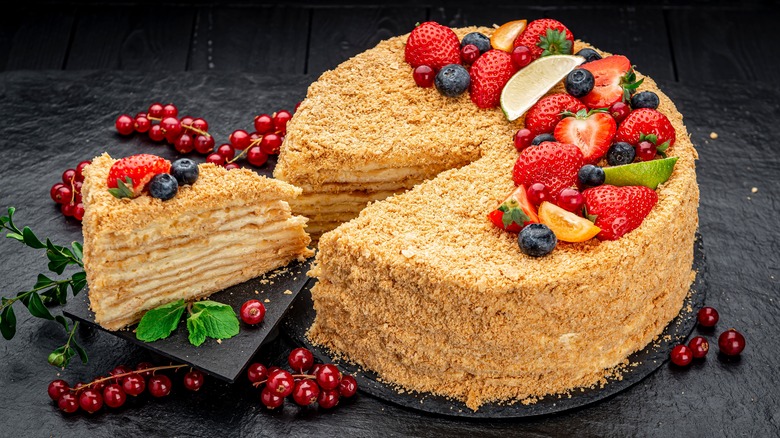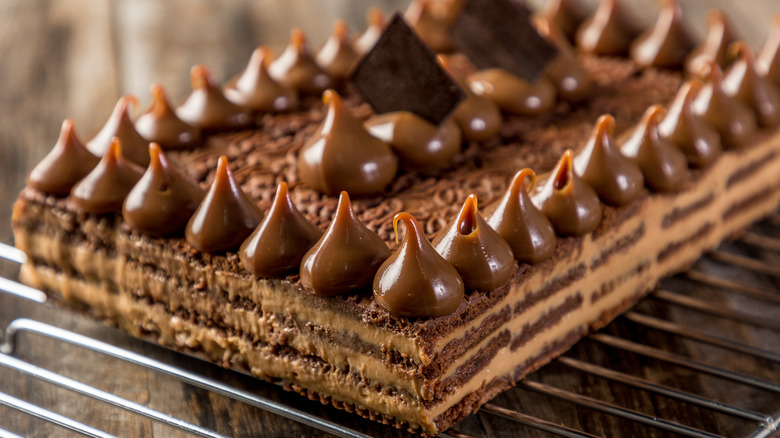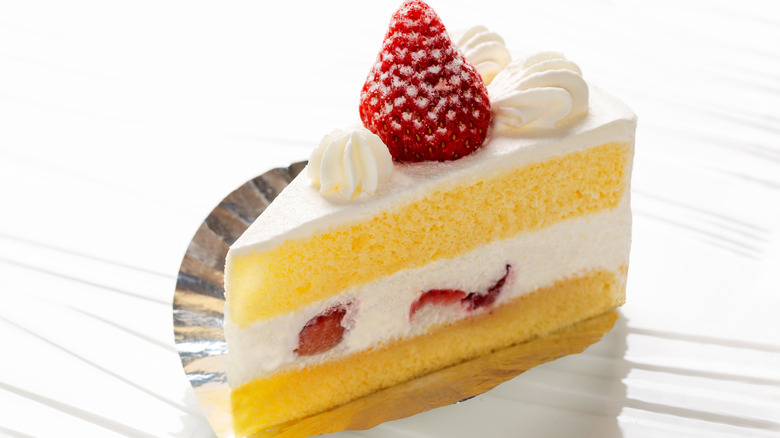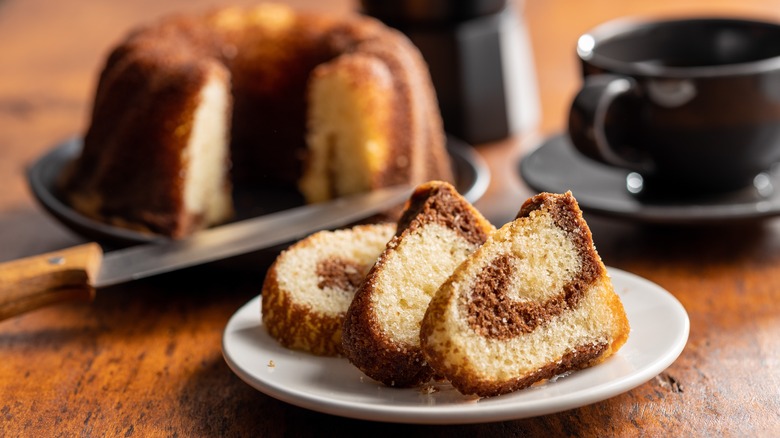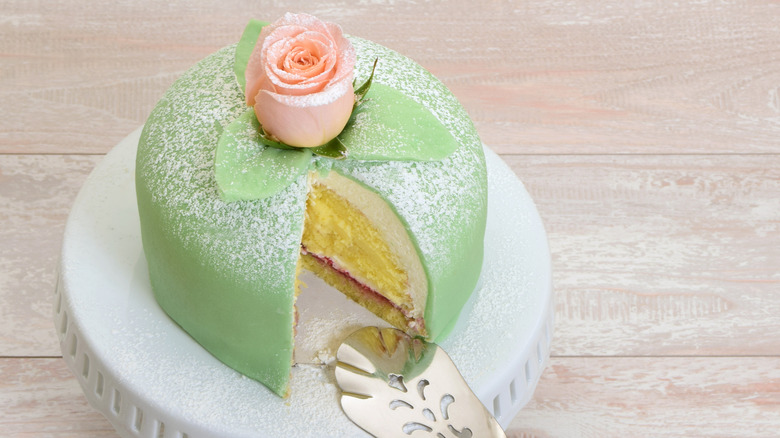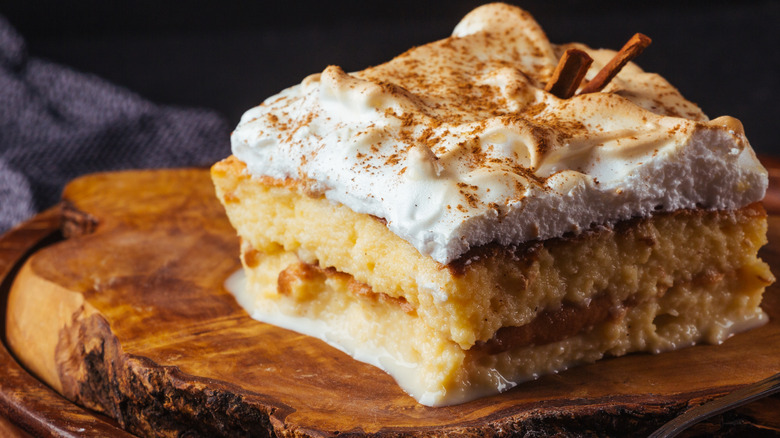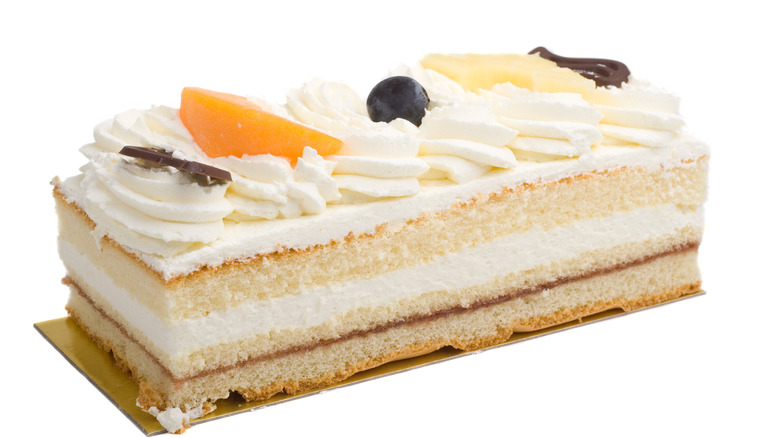How Birthday Cakes Look Around The World
If you think anything like us, cake is one of the best parts about birthdays. Whether it's storebought or carefully handmade, elaborate and multi-tiered or simple but delicious, birthdays are an exciting time for the cake lovers in our midst. Maybe you're used to being presented with classic yellow cake, chocolate fudge cake, or even a fancy bundt to celebrate another year, but birthday cakes differ across the globe.
From cream-filled Norwegian bløtkake to mujigae-tteok served on special birthdays in Korea, you'll find a wide range of birthday cakes eaten around the world. Of course, not every country has just one traditional treat. As food becomes increasingly global, people might not stick to their country's traditional birthday cake to celebrate their annual rotation around the sun. However, the following cakes we've featured continue to be popular choices in their country of origin.
As you discover more about birthday cakes around the world, prepare to get an intense craving for baked goods. You never know, you may just find your dream birthday cake.
America: Yellow cake
Anyone who's celebrated their fair share of birthdays in the U.S. has probably blown out the candles on more than one yellow cake. This vanilla cake has a golden hue that comes from the use of whole eggs and butter in the recipe. What's great about yellow cake compared to white cake is that you don't have leftover egg yolks to deal with (white cake only uses egg whites to give it a pale color). There's also no chance that being heavy-handed with the vanilla extract will affect the hue, so you can make it more intensely aromatic.
Yellow cake makes an excellent canvas for a range of frostings. You can stick with classic vanilla, contrast it with chocolate, or opt for any kind of fruit frosting, such as lemon or raspberry. Some people like to get elaborate with decoration, using a piping nozzle to create frosting swirls and rosettes. However, yellow cakes look great even if they're naked or semi-iced. It's also not uncommon to have "Happy Birthday" piped on the cake, along with the birthday person's name. Even if yellow cakes might seem simple at first glance, there's plenty of variation and lots to love about them.
Italy: Rum cake
Italian cake fans are in luck because the boot-shaped country has plenty of delicious tortas to choose from. Rum cake is a popular choice for special occasions such as birthdays, so we thought it deserved a spot on this list and a place in our hearts — and stomachs.
The foundation of an Italian rum cake is a light, airy sponge cake known as pan di Spagna, which translates to bread of Spain. The cake layers are often soaked in a mixture of rum and simple syrup, imparting a delightful boozy essence to every bite. The rum syrup not only enhances the flavor but also keeps the cake incredibly moist, ensuring a melt-in-your-mouth experience.
Between the layers of sponge cake, you will often find a generous filling of pastry cream or whipped cream. The cream adds a velvety smoothness and a touch of indulgence to the cake. Some variations may include a layer of fruit preserves or fresh fruit, adding a burst of goodness. Chocolate pastry cream is another option that certainly shouldn't be overlooked.
The outside of the cake is usually frosted with whipped cream that has been stabilized to make it stand up to spreading and piping. Whether adorned with piped decorations, chocolate shavings, or fresh fruits, expect some kind of flourish to signify the special occasion.
Norway: Bløtkake
Bløtkake, a Norwegian delicacy, is a simple and elegant dessert that holds a special place in the hearts and taste buds of Norwegians. Since it's considered a celebration cake, it's a popular choice to serve on birthdays for Norwegians of all ages. Bløtkake, meaning soft cake in English, accurately describes the delicate, tender texture.
It consists of three layers of sponge sandwiched with whipped cream, though it's often so much more than just that. Many people in Norway have their own family recipes for bløtkake, so not every filling is the same. Vanilla custard and fruit are commonly nestled between layers of sponge, alongside the whipped cream.
The exterior of the cake is traditionally frosted with pillows of whipped cream, giving it a light texture that isn't overly sweet. For birthdays, it's usually decorated with blueberries and either strawberries or raspberries to form the Norwegian flag. However, some people — especially the younger generation — may prefer to decorate it more loosely with fruit, rather than sticking to the flag design.
France: Tarte aux fruits
When is a birthday cake not a birthday cake? When it's a fruit tart, of course! Tarte aux fruits is a hugely popular French dessert. It's so popular, in fact, that lots of people choose to enjoy it on their birthdays, in place of a more traditional cake.
French fruit tarts are often made using seasonal fruits, so the filling tends to vary depending on the time of year. Strawberries are common guests of honor at the fruit tart party, as are kiwis, peaches, mangoes, blueberries, and apricots. The only rule is that these fruits should be soft, so crunchy fruits such as apples aren't invited.
The foundation of a tarte aux fruits is a rich, buttery shortcrust base. Layered inside, you'll find delectable pastry cream — also known as crème pâtissière. This is akin to a custard, with a thicker consistency that can hold its shape when the tart is sliced. Next comes the fruit, which is usually arranged artistically, with contrasting colors to accentuate its natural beauty. On top, an apricot glaze adds sweetness and an attractive sheen to the tart.
It isn't cake but it's certainly celebratory and fit for any birthday. It can also be made in individual serving sizes. If cake isn't your bag, maybe you need to request a fruit tart next time around.
Korea: Mujigae-tteok
Rainbow rice cake — known in Korean as mujigae-tteok, is unlike any of the other birthday cakes on this list. It's made from glutinous rice flour and steamed, giving it a unique texture. It also comes in a range of colors — usually between three and five — arranged in layers, a little like a rainbow cake.
However, you won't find mujigae-tteok at every Korean birthday party. Rather, it's reserved for special milestone birthdays. For example, it's often prepared to celebrate a baby's first birthday or a significant year like a 60th birthday. Both of these are considered big milestones and are celebrated with a feast.
This isn't solely a birthday cake, however, as it's also served up at important events, such as weddings. There's no additional decoration on a rainbow rice cake, as the bright colors do all the heavy lifting. Colors are added to the rice flour dough using natural coloring, including gardenia powder to form a yellow layer and devil's-tongue powder to form a pink layer.
Ukraine: Napoleon cake
A Ukrainian take on mille-feuille, the Napoleon cake is a common choice for birthdays. Although it originated in Russia, ultimately, this cake can be traced back to France, where it was named after Napoleon Bonaparte, the renowned French military and political leader. The cake gained popularity in Ukraine during the Soviet era and has since become a staple in Ukrainian cuisine (with its own twist), especially for birthdays and other celebratory events.
Napoleon cake isn't a cake as you know it; there's no sponge. Instead, it's made up of lots of thin layers of puff pastry with vanilla whipped cream in between. The cream is made by combining homemade custard with whipped heavy cream. The exterior of the cake is also covered with vanilla cream, which is one of the ways it differs from a traditional mille-feuille (it also has many more layers).
Once it's been constructed, the cake is left in the fridge overnight. This lets the cream sink into the puff pastry, resulting in a soft texture rather than its usual crisp finish. The exterior is then encrusted with more pastry crumbs and may be decorated with fresh fruit, although this extra garnish is optional.
Argentina: Chocotorta
Chocotorta is a beloved dessert that holds a special place in the hearts of many Argentinians. It is a classic no-bake cake that combines simple ingredients to create a delightful and indulgent treat. Loved for its rich chocolate flavor and creamy texture, chocotorta has become a staple at birthdays throughout the country.
The main ingredients used are chocolate cookies, typically the brand Chocolinas, which are essentially plain chocolate biscuits. The cookies are soaked in a mixture of coffee and milk, which gives them a soft cake-like texture. The coffee infusion adds a subtle depth of flavor too, complementing the sweetness of the cookies.
Layered between the soaked cookies is a creamy filling made from dulce de leche and cream cheese. Dulce de leche, a thick caramel-like spread made from condensed milk, is a beloved ingredient in Argentinian cuisine. Its rich velvety sweetness pairs perfectly with the chocolate and coffee flavors in chocotorta. Cream cheese adds a tangy note and a smooth consistency to the filling.
Before serving, the chocotorta is often decorated with a dusting of cocoa powder or chocolate shavings. Some variations may include additional toppings like whipped cream or chopped nuts for texture and a touch of flair. Chocotorta is not only adored for its taste but also for its ease of preparation, considering it requires no baking and can be assembled in a short amount of time.
Japan: Strawberry shortcake
You might be used to American strawberry shortcake, where the baked element is akin to a biscuit or scone, but Japanese strawberry shortcake is different. Also known as ichigo shortcake, the dessert is a popular favorite and commonly served on birthdays.
The cake is light and delicate thanks to layers of soft airy sponge cake, fresh strawberries, and whipped cream. It's often prepared using a genoise-style recipe, which involves beating eggs and sugar together to create a light and fluffy texture. The cake is then baked and cooled before being sliced into multiple layers.
These layers are sandwiched with whipped cream and sliced fresh strawberries, for a result that looks as good as it tastes. The use of whipped cream instead of standard frosting means that it isn't as sweet as typical American birthday cakes. Bad news if you have a serious sweet tooth, but great news if you're often overwhelmed by sickly sweet buttercream frosting.
The exterior of the cake is often completely covered in whipped cream, but the sides may be left bare to show off the layers of sponge, strawberries, and cream. For special occasions such as birthdays, the top of the cake is decorated with piped cream and fresh strawberries.
Germany: Marble cake
If you're used to towering tiered birthday cakes layered with rich frosting and decorated elaborately, you might find this typical German birthday cake plain and unassuming. While there are many types of cake eaten in Germany to celebrate birthdays, marble cake is a common choice. The cake gets its name from the marbled pattern created by mixing two contrasting batters: one vanilla and the other chocolate. The combination of these two flavors creates a cake that looks great and tastes amazing.
To achieve the marbled effect, a portion of a standard vanilla batter is mixed with cocoa powder or melted chocolate to create a rich, decadent chocolate batter. The vanilla batter is poured into the pan first, followed by dollops of chocolate batter. The two are then swirled together with a skewer or knife to give the cake a marbled finish when baked. It might surprise you to learn that this German cake isn't frosted at all. However, to make it more celebratory for birthdays, it's often cooked in a Gugelhupf pan, which is similar to a bundt pan.
Sweden: Princesstårta
Princesstårta — or princess cake — was originally created in Sweden in the 1930s. It has become a beloved dessert associated with special occasions in Swedish culture, particularly birthdays. Its exquisite presentation and indulgent flavors make it a centerpiece that adds a touch of elegance and sophistication to any gathering.
The base of the cake is a light sponge cut into three slices and layered with raspberry jam and pastry cream. The raspberry jam adds a delightful tang and a burst of vibrant color to the cake. The fruit balances the sweetness of the pastry cream and adds a tart, refreshing element to each bite. After layering the sponge, it's topped with a generous heap of whipped cream that's formed into a dome.
This provides a base for a layer of green marzipan that sits over the entire cake. The whipped cream gives it the distinctive domed shape that princess cake is known for. Finally, the cake is often decorated with powdered sugar and a pink marzipan rose. This isn't an easy cake to bake yourself at home, but if you can pull it off, it's bound to impress.
Mexico: Tres leches cake
Birthdays are celebrated with flair in Mexico. The day kicks off with a rendition of the birthday song Las Mañanitas, followed by a day of celebration that often includes a tres leches cake. This cake is renowned for its rich, moist texture and its unique preparation method that involves soaking the cake in a mixture of three different types of milk. Aside from the delicious result, this step also gives the cake its name, which translates to three milks.
The base of a tres leches cake is a pretty typical sponge cake, but once baked and cooled, it's time for the signature step: the soaking process. First, the cake is carefully pierced all over with a fork or toothpick to create channels for the milk mixture to seep into the cake and be absorbed. A mixture of milk is poured over the cake, typically a trio of condensed milk, evaporated milk, and heavy cream, although variations exist. As the cake soaks, it becomes incredibly moist, taking on a luxurious and almost pudding-like consistency. Finally, it's topped with sweetened whipped cream and cinnamon — a delightful birthday treat.
Denmark: Kagemand
For children in Denmark, a kagemand is the go-to birthday dessert. While it may be described as a cake, the dough is often yeasted and has more in common with a pastry than a true cake. Nonetheless, it's the most popular cake for little ones — and sometimes even for adults who want a nostalgia trip. Also known as cake man, the kagemand is shaped into the form of a person, with a round head, a body, arms, and legs. It's then decorated with frosting, chocolate, and candy. Depending on the chef's artistic skills, it may be extremely detailed or fairly rough.
The kagemand tradition is deeply ingrained in Danish culture and continues to be cherished and enjoyed by families across the country. It might sound a bit dark, but eating the kagemand usually begins by beheading or dismembering it while the children at the party scream. In recent years, there has been some discussion and debate about the gendered aspect of the kagemand, as it traditionally represents a male figure. As a result, there has been a movement toward creating kagekone, or cake woman, to offer a gender-inclusive option.
Netherlands: Slagroomtaart
Get your mind out of the gutter — a slagroomtaart is simply a type of cream cake from the Netherlands, that is commonly enjoyed on special occasions and celebrations such as birthdays. The base of a slagroomtaart is a sponge cake, which serves as a foundation for the generous layers of whipped cream. The cream is whipped to a fluffy and velvety consistency, often sweetened with a touch of sugar and flavored with vanilla extract. This creamy layer adds a decadent touch to the cake.
In addition to the whipped cream, fresh fruit such as strawberries, raspberries, or cherries are commonly incorporated, adding a burst of color and freshness in contrast to the heavy cream. Some variations may include a thin layer of jam or custard between the sponge cake layers for added flavor and moisture.
The final touch to a slagroomtaart tends to involve some garnishing elements. This can include piping the whipped cream into decorative patterns, adding chocolate shavings, sprinkling colored sugar, or adorning the top with fresh fruit or edible flowers. Slagroomtaart is typically served chilled, allowing the whipped cream to maintain its airy texture and keep the cake moist.
